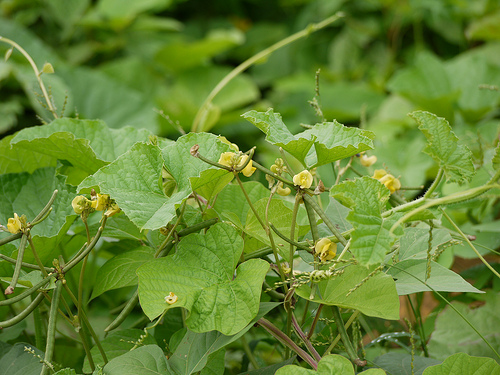How to make big in Mongo production?
Mongo production is an added income for farmers while waiting for two months to start another season of corn or rice production. The value of this production is gaining grounds as market and price are high this time.

Photo by dinesh_valke
Technical Description
Mungbean (Vigna radiata Wilczek), commonly called mongo, is the cheapest source of vegetable protein with protein content of 20-25 percent. It is rich in vitamins, calcium and sodium, which are usually deficient in most bean diets. It is an excellent crop for green manuring, because it matures early, grows fast and produces abundant vegetative tops.
Utilization
Mungbeans are mainly utilized for human food: infant supplements, snacks, desserts and viands. It is a basic ingredient in popular food items like hopia, butse-butse, sotanghon and halo-halo. It is cooked with meat or shrimps or served as vegetable dish. It is the basic material in the preparation of piyaya, an ilonggo delicacy. Its sprouts in meal dishes are very popular not only in the Philippines but also in Japan, Korea, Taiwan and Thailand. It is also a relovent, carminative and antipoisoning agent.
Farm Practices
Mongo is a Nitrogen-rich crop used in intecropping rotation and relay cropping. Farmers plant mongo during the second cropping season due to its low moisture content. It is fairly drought-tolerant crop with a short maturity period. It is also used as a substitute for soybean meal in poultry feed formulation.
Mongo is planted by row-grill method, or broadcast method. Harvesting starts within 65-72 days after planting when pods turn brown or black and leaves turn yellow. It is done by handpicking the pods which are then sundried, threshed and packed in sacks.
Specifications
Most common varieties are the native and Imelda. The grains of the native/Imelda variety are green and yellow but the grains are in native than that of Imelda variety.
Whole mongo grains are available for wholesale buying and selling in sacks of 25-30kg each. The minimum volume transaction is one-half sack.
Retailers sell both green and yellow using either big nescafe glass weighing 350gms, one liter caltex can weigh 0.5kg or a salmunan weighing 0.25kg.
Seasonality
Mongo is abundant from February to May, coincides with the second and third cropping season. During the lean months of June to January, mongo from manila augment local supply.
Price Formation and Differentiation
Traders based their prices on demand and supply forecasts. During peak supply of mongo, prices dip by P3.00 to P4.00 per kilogram. On the other hand, prices rise by P5.00 to P6.00 per kilogram during lean months. Imelda variety fetches a higher price in the market.
Market Flow
Farmer/Producer -> Wholesaler/Middlemen -> Retailer -> Consumer
Farmer/Producer -> Processor -> Retailer -> Consumer
Farmer/Producer -> Processor -> Consumer
Farmer/Producer -> Consumer
Marketing Practice
Bulk of farmer’s produce is sold to agents, retailers, wholesalers, wholesaler-retailer, assembler-wholesaler, and processor. Only small quantity is left for food and feeds.
Source: Department of Agriculture

where can i buy imelda. i’m from candelaria quezon
Contact no.nyo sir? Tnx
It will be big help for us farmers and producers of mongo beans if you also publish in your website the names, address, and contact numbers of mongo bean buyers so we can sell our products without going thru agents or middlemen.
Good day Mr. Felix Conde,
May we ask for your contact number so we can call you regarding mongo seeds.
Thank you
Minda Cilos
0906-7879733 / 0907-22701081
i live in north caloocan .. can you please refer me to the nearest supplier? magkano po pag 1 sakong munggo muna? tnx … ilang kilo un? 0921 287 3577
Hi Felix good am. ask ako ng contact number ng monggo bean seed producer. or please contact me or kindly give my number to them 09365274693. emy varona here. Thank you